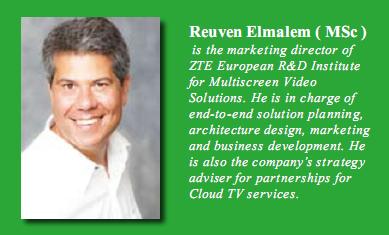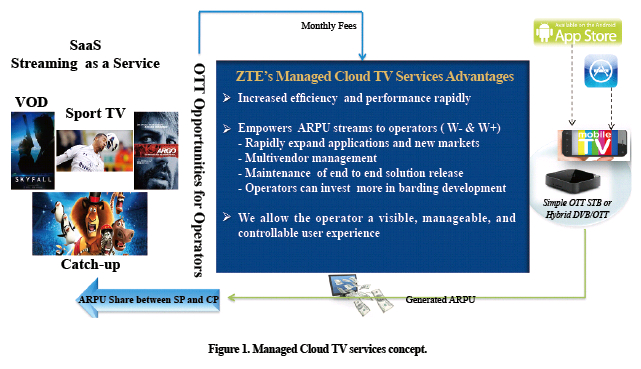Managed Cloud TV: A Growing Necessity for Operators and Content Providers
 The uptake of OTT services and IPTV solutions to deploy video to a plethora of multimedia enabled devices is now widespread and their daily use is increasingly commonplace. Video in its various guises (TV, video on demand and internet) will account for over 90% of worldwide consumer internet traffic in 2014.
The uptake of OTT services and IPTV solutions to deploy video to a plethora of multimedia enabled devices is now widespread and their daily use is increasingly commonplace. Video in its various guises (TV, video on demand and internet) will account for over 90% of worldwide consumer internet traffic in 2014.
The combination and integration of OTT-TV with IPTV creates an offering that allows IPTV providers to expand their service to include a much wider and more diverse audience (off-net users). This may open up the system to the possibility of increasing revenue from streams such as advertising and customer profiling.
By combining both architectures, television broadcasters will be able to provide many new services, rapidly expanding their existing geographic footprint without the need for significant capital expenditure. The key to combining the two technologies is that end users only see a single sign on service. An OTT platform integrated with subscribers who use hybrid set top boxes will allow content providers to combine existing linear television services with new on demand services, and advertise all this content using a single electronic program guide (EPG). The on demand services can be a mixture of streaming media and existing stored media. Television is mostly made up of a sequential play out of pre-existing assets with very little genuinely live content.
With increased competition from OTT players and the need to innovate at lightning speed, more and more European operators are starting to consider the role of managed Cloud TV in their video strategies for on-net and off-net subscribers.
Decreasing revenue from traditional sources, such as voice and text messaging, as well as an increasing number of smartphones in the mainstream and prevalence of 4G networks, mean that mobile operators have to offer new, compelling value-added services to their customers if they want to stay competitive. At first glance, telcos might not appear to be the obvious choice for delivering content. However, as core communication revenues decrease―both because of cable companies’ bundling of voice, data and TV services and the increasing number of mobile devices―telcos have to find alternative sources of revenue. Extending fiber-to-the-home is often impractical and not cost-effective, and it still does not facilitate full mobility.
Consumers are turning away from traditional TV screens towards connected devices that provide on-demand entertainment and that may be used as secondary screens. DVB satellite and MSO cable operators therefore have to extend their offerings to satisfy consumer demands. If they do not, they face risks in terms of better-positioned competitors, “cord-cutting,” or even “never-corded” consumers. New long-tail customers can also be acquired with cloud-only offerings that serve the flexible needs and pricing sensitivities of these customers on a range of mobile devices.
If operators are slow to adopt cloud infrastructure, they will miss the boat on the new market opportunities that their customers want. Missed opportunities may be hidden and range from improper online content protection to time wasted figuring out the right Cloud TV solution. Successful adoption of cloud-based workflows and rights management can mean increased control and visibility and reduced complexity. It is also an opportunity to attract new customers and can mean that costly hardware-based bottlenecks and aging resources can be reduced without sacrificing content security or user experience.
Centralization and efficiency seemed nearly impossible a few years ago, when the multi-screen revolution was beginning. Experience has taught us that what operators are really looking for is simplification without sacrificing user experience. A cloud-based, one-stop shop is not only efficient for technology implementation but also satisfies legal requirements and core business objectives. With a trusted partner to take care of the services platform, CDN, multi-DRMs and user experience components, content owners and telcos are free to take greater ownership of the brand experience. As a multi-screen partner, ZTE ensures the required level of flexibility by introducing state-of-the-art technology providers and ensures telcos stay ahead of the curve and avoid bottlenecks.
ZTE’s optimized cloud streaming is robust telco-grade infrastructure that is optimized for the absolute best streaming over the open internet and for mobile devices. The use of adaptive streaming has created a distribution method that is highly effective and easily implemented. HTTP protocol traffic can offer effortless video streaming by avoiding NAT and firewall issues while in some instances allowing the client control over the stream.
Delivering to a variety of devices and to OTTs is complex and may be perceived as an unmanageable task by operators who are ill-prepared to meet demands. The cloud can help here, but the first hurdle is accepting that the consumer ultimately dictates what platforms (e.g. Apple, Android, Windows and Linux devices) you must support and which services (e.g. live, VOD, and catch up) you must offer. There is no one size fits all approach to delivering content in this fragmented environment. Cloud TV offers tremendous scalability and the highest level of reliability, which is needed to support OTT/TV services everywhere. For example, using OTT to deliver live sports to mobile devices is becoming increasingly popular. However, this can cause huge traffic bursts. It is difficult for any in-house solution to support this in a cost-effective way. Therefore, it is necessary to create a roadmap to evaluate which devices, platforms, and services are needed. This is the starting point in streamlining content delivery and, ultimately, advancing end-user experience through the cloud.
Content and value-added services powered from the cloud based platform are:
● lineal channels (Live TV). This is a line-up of the DTH channels, which comprise HD and SD channels; TV on-demand, which includes content classified as traditional or premium; and catch-up TV, which includes content recorded from a selection of lineal channels.
● VOD catalogue. A VOD catalogue is displayed, and content is rented.
● EPG. A program grid containing lineal channel content is displayed, and reminders, advanced recommendations, and search engine tools are defined.
● social TV. This includes real-time interactions between Facebook users (Share, Like&Tag friend per asset & liveTV event etc.).
● self service Web portal. This includes account configuration, user devices, and profiles.
● devices. These include OTT Android-based set-top boxes (pure OTT and hybrid DVBx/OTT), PC/MACs, and tablets and smartphones using Android or Apple OS and more.

As a multi-screen solution provider, ZTE ensures that content is delivered in the right size, format, and bit rate. Managing content well is vitally important. A content preparation, rights, and security solution workflow needs to be agnostic, flexible, scalable, and able to create order from chaos. Content preparation should not introduce unnecessary complexity into the content-preparation workflow but should actually save time and money in both the short and long term. Ultimately, the right multi-screen partners enable better agility in the cloud. Among other things, the cloud can be a good tool for extending geographic reach and bringing new services to market quickly and cheaply. A good partner should be able to tie subscriber information to content preparation, user policies, user experience and other components seamlessly into a cloud service.
Subscribers expect to receive a PayTV services (via satellite, cable, telco, mobile or ISP) as part of a true multi-service domain. They expect to access premium content at the time of their choice, on any screen they own and, most importantly, they want a personalized experience to match individual tastes and satisfy their lifestyle.
An operator needs an established customer base as well as reliable infrastructure. You may be a pay TV operator interested in reducing “cord cutting” by expanding your existing TV offering to multiple devices. Or you may be a multi-play operator or telco interested in generating a new revenue by creating your own TV platform. In either situation, ZTE can ensure you fully utilize your existing assets to meet your needs. This requires leveraging of the existing service backend and integrating with the right platform to manage content, offerings, and user experience for total OTT expansion. ZTE’s cloud-based TV platform has a proven track record of being integrated into the existing operators OSS back-end billing, CRM, BI, and operations system in order to service subscribers in the best possible way.